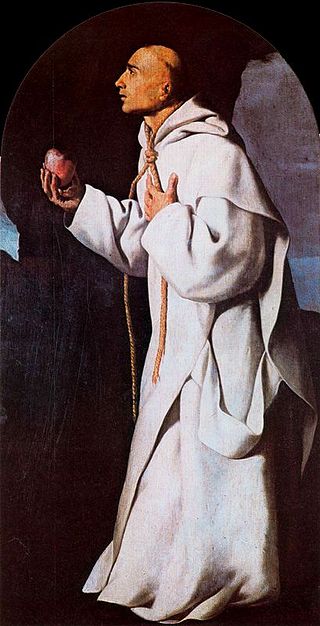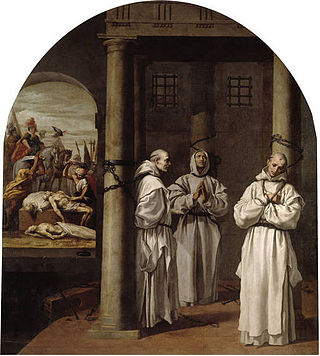
Richard Reynolds, OSsS was an English Bridgettine monk executed in London for refusing the Oath of Supremacy to King Henry VIII of England. He was canonised by Pope Paul VI in 1970, among the Forty Martyrs of England and Wales.

The Forty Martyrs of England and Wales or Cuthbert Mayne and Thirty-Nine Companion Martyrs are a group of Catholic, lay and religious, men and women, executed between 1535 and 1679 for treason and related offences under various laws enacted by Parliament during the English Reformation. The individuals listed range from Carthusian monks who in 1535 declined to accept Henry VIII's Act of Supremacy, to seminary priests who were caught up in the alleged Popish Plot against Charles II in 1679. Many were sentenced to death at show trials, or with no trial at all.

Augustine Webster, O.Cart was an English Catholic martyr. He was the prior of Our Lady of Melwood, a Carthusian house at Epworth, on the Isle of Axholme, in north Lincolnshire, in 1531. His feast day is 4 May.

John Houghton, OCart was a Catholic priest of the Carthusian order and the first martyr to die as a result of the Act of Supremacy by King Henry VIII of England. He was also the first of the Carthusians to die as a martyr. As one of the Carthusian Martyrs of London he is among the Forty Martyrs of England and Wales.
Thomas Johnson, O.Cart., was a Carthusian hermit who was executed by starvation in Tudor England. He is venerated as a martyr and has been beatified by the Catholic Church.
Maurice Chauncy was an English Catholic priest and Carthusian monk.

John Rochester was an English Catholic priest, Carthusian monk and martyr. He was hanged at York for refusing to concede King Henry VIII's supremacy over the church.

William Exmew, O.Cart was an English Catholic priest and Carthusian hermit. He was hanged, drawn, and quartered at Tyburn and is honoured as a martyr by the Catholic Church. Exmew and his brother Carthusian martyrs were beatified by Pope Leo XIII on 9 December 1886.

Sebastian Newdigate, O.Cart was the seventh child of John Newdigate, Sergeant-at-law. He spent his early life at court, and later became a Carthusian monk. He was executed for treason on 19 June 1535 for his refusal to accept Henry VIII's assumption of supremacy over the Church in England. His death was considered a martyrdom, and he was beatified by the Catholic Church.

The Carthusian Martyrs of London were the monks of the London Charterhouse, the monastery of the Carthusian Order in the City of London who were put to death by the English state in a period lasting from the 4 May 1535 until the 20 September 1537. The method of execution was hanging, disembowelling while still alive and then quartering. Others were imprisoned and left to starve to death. The group also includes two monks who were brought to that house from the Charterhouses of Beauvale and Axholme and similarly dealt with. The total was 18 men, all of whom have been formally recognized by the Catholic Church as martyrs.
John Larke was an English Catholic priest and martyr, who was executed during the reign of Henry VIII. Larke was a notable personal friend of Thomas More, Lord High Chancellor of England. Larke was beatified in 1886 by Pope Leo XIII.

Peter Blomevenna Dutch: Pieter Blommeveen; 29 March 1466 in Leiden – 14 August 1536 in Cologne) was a Carthusian author and prior of Cologne Charterhouse from 1507 to 1536.
Robert Lawrence, OCart was one of the Forty Martyrs of England and Wales. He was hanged, drawn, and quartered at Tyburn for declining to sign the Oath of Supremacy. His feast day is 4 May.

Beauvale Priory was a Carthusian monastery in Beauvale, Nottinghamshire. It is a scheduled ancient monument.
Axholme Charterhouse or Axholme Priory, also Melwood Priory or Low Melwood Priory, North Lincolnshire, is one of the ten medieval Carthusian houses (charterhouses) in England. It was established in 1397/1398 by Thomas Mowbray, Earl of Nottingham and later Duke of Norfolk. The house was centred on a pre-existing chapel on the present Low Melwood Farm, between Owston Ferry and Epworth in the Isle of Axholme, which according to a papal bull of 1398 "was called anciently the Priory of the Wood".

La Valsainte Charterhouse or La Valsainte situated in La Valsainte in the district of Gruyère, Canton of Fribourg, is the only remaining extant Carthusian monastery in Switzerland.
Sheen Friary later also known as Richmond Priory (1414-1539) was a friary in Surrey, England, restored as a national gathering of Carthusians by Maurice Chauncy at Sheen under Mary I of England during part of her reign from 1553 to 1558.
John Batmanson, was prior of the Charterhouse in London.

The Carthusian martyrs are those members of the Carthusian monastic order who have been persecuted and killed because of their Christian faith and their adherence to the Catholic religion. As an enclosed order the Carthusians do not, on principle, put forward causes for their members, though causes have been promoted by others on their behalf.











